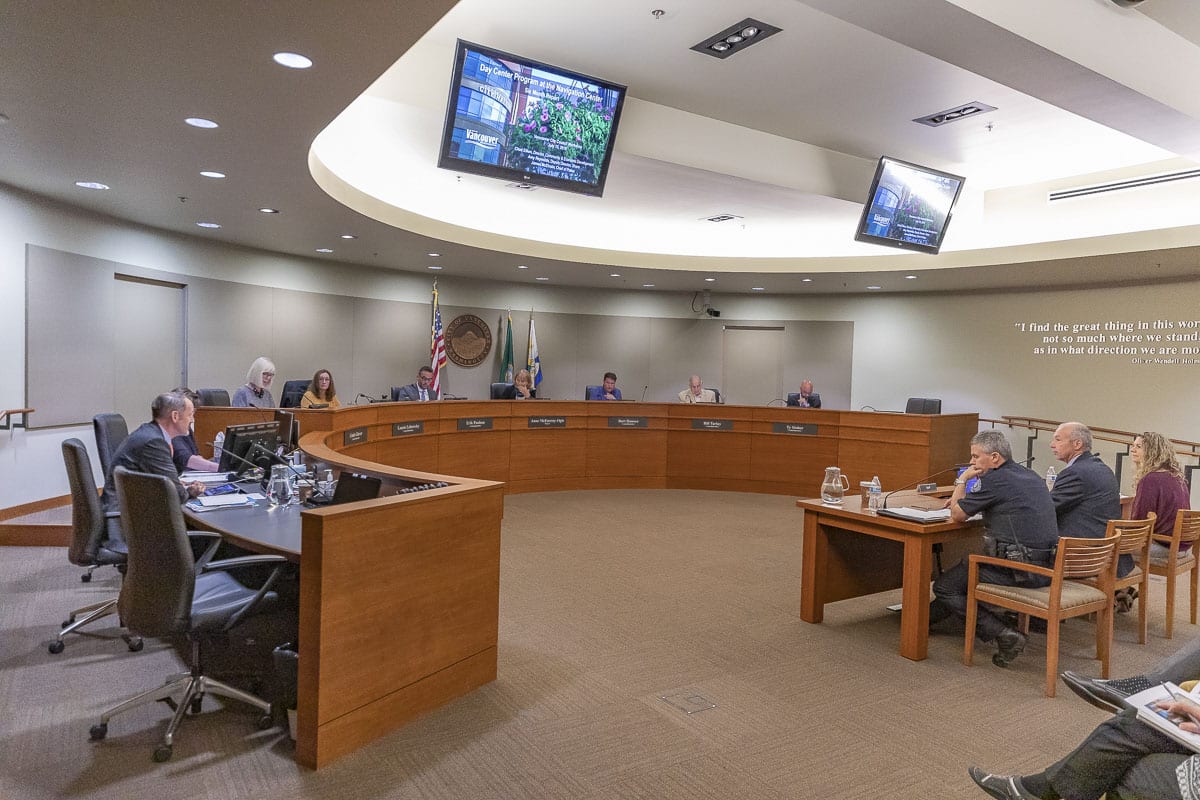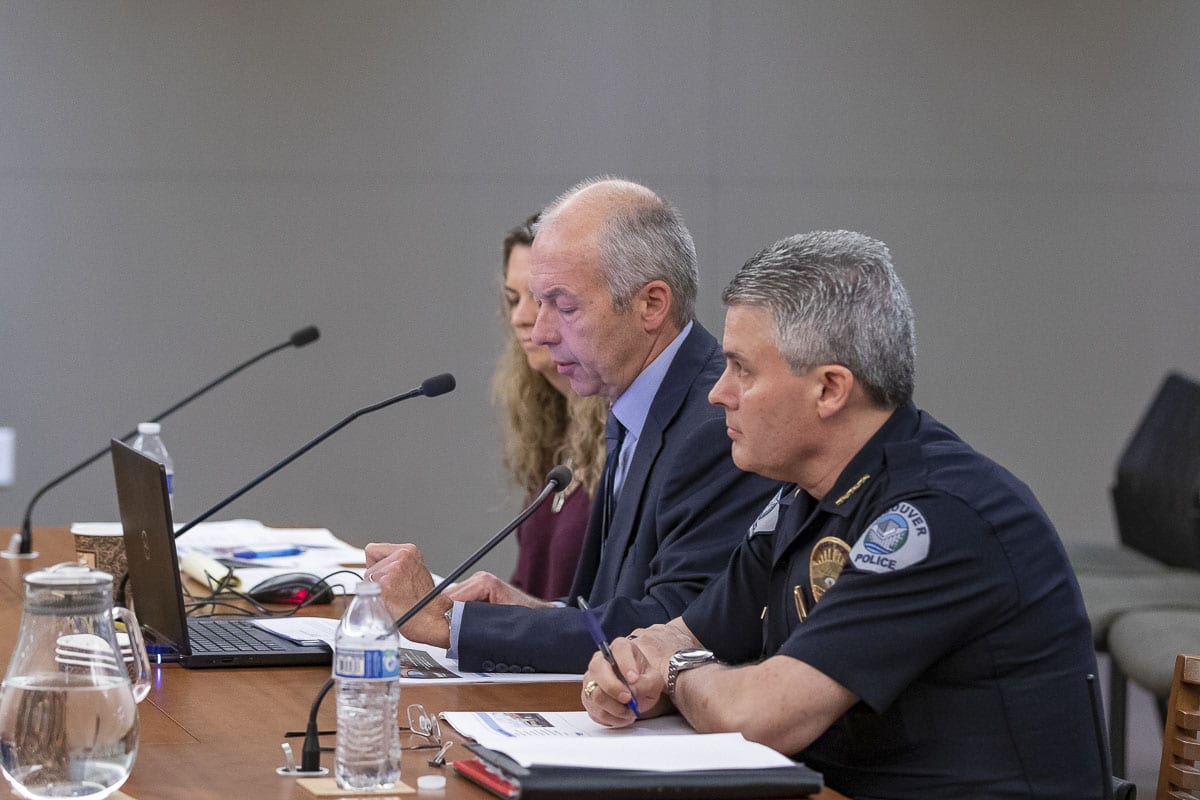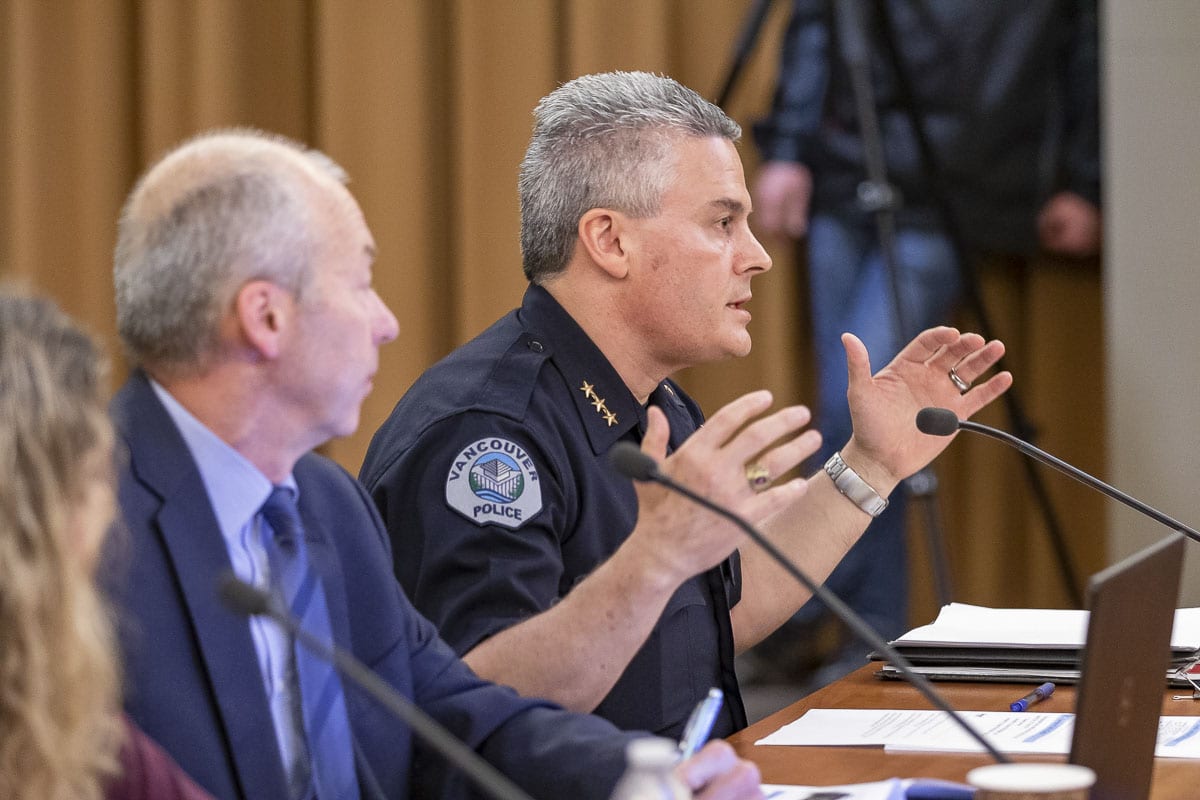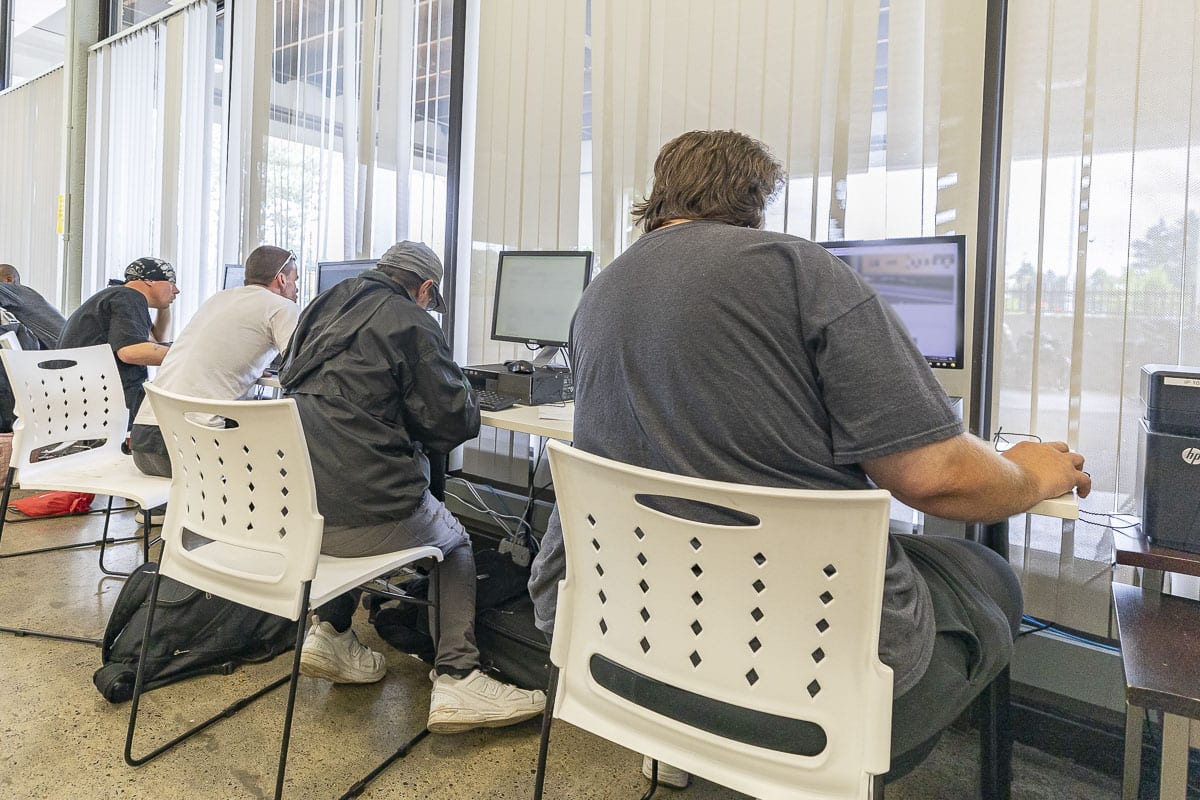At a Monday work session, the group urged an outside review of operations at the day center run by Share as complaints mount
VANCOUVER — The six-month mark of the Share-operated homeless day shelter inside the Vancouver Navigation Center at Fourth Plain and Grand Boulevard was met with growing frustration from Vancouver City Council members at a work session on Monday evening.

“This did not meet my expectations,” said Council Member Ty Stober at the end of the presentation from Share Deputy Director Amy Reynolds, Vancouver Police Chief James McElvain, and Community and Economic Development Director Chad Eiken. Stober had said during the July 1 council meeting that he hoped to hear personal responsibility taken for issues around the Navigation Center and innovative solutions to the problems.
“I don’t feel comfortable with some of the self-assessment that’s been presented to us,” concluded Stober.
In her presentation, Reynolds said traffic in the day center has outpaced initial expectations, with daily visits now averaging nearly 100 people. Currently, the facility has between 4-5 staff members on site during weekdays, and four during the weekend. That number was initially determined based on an expected maximum usage of 75 people per day, so Eiken said the city is looking into assisting Share with bringing at least one more person on, potentially to deal especially with issues of people loitering on the sidewalk outside.
“We’ve been talking to Share about creating an ambassador position,” said Eiken. “Someone who is comfortable going out and talking to maybe some of the rougher people who hang out on the sidewalk outside of the center and can encourage them to move on or come into the center.”
The city is also exploring the option of a mid-block crossing across Grand Boulevard, and potentially lowering the speed limit from the current 30 mph to 25 mph.
Who’s using the day center
Reynolds says 1,412 people have used the day center as of last month, representing a total of nearly 20,000 visits. Of those individuals, nearly half made use of the facility’s showers, which are open from 8 a.m. to 2 p.m. daily. A total of 566 people made use of a bank of laundry machines to do nearly 3,000 loads of laundry.
Out of those shelter visits, Reynolds says 48 people obtained employment, 70 were connected to non-emergency housing, and 377 were directed to emergency shelters. While that represents a small percentage of the overall shelter population, Reynolds and Eiken said issues with the lack of affordable housing options remains the largest barrier to getting people into new places.
“The city is really using all of the tools at its disposal, and has even created a tool in the affordable housing fund to increase the number of affordable units,” said Eiken. “And so that work just needs to continue.”

Reynolds said the number of people using the shelter has been a surprise, especially given the fact they don’t offer warm meals there.
“We had been told for many years that it was our hot meal program that drew people to Share House, and that if we didn’t move the hot meal program that we wouldn’t see an increase in numbers,” said Reynolds. “We didn’t move the hot meal program and we weren’t sure if we would see a significant amount of people. But as you can see by the numbers, we’ve served significantly more than we expected with an average of 99 a day.”
Reynolds also noted that one of the more concerning trends was the increase in older people experiencing homelessness. Between Nov. 19, 2017 and June of last year, Share served 163 people between the ages of 51 and 61. During the same time period this year, that number increased to 349. The same trend holds true for people 62 and older.
“During that time period between 2017 and 2018, we served 41 people who were 62 and over,” Reynolds said. “During the same time period of this last year we served 103 who are 62 and over.”
The rapid growth of those using the day center has brought additional challenges. The city’s operational agreement with Share budgeted $445,800 for operations this year. Eiken said the need for additional staffing and dedicated security mean the city is looking at an estimated $179,000 funding gap for the remainder of this year.
Some of that money is also slated to be spent on increasing security for the Navigation Center, including a key card access system and other methods of restricting access to the covered area outside of the day center at the request of Vancouver Police.
Despite the recommendation, Reynolds maintains the low-barrier system is best practice for this type of shelter.
“Often people who don’t have as many barriers are able to move faster through the system,” said Reynolds, “and the people who remain homeless and cost the system the most have a multitude of issues, and creating high barrier systems excludes them from getting any help and just leaves the police to be able to work that population.”
According to the presentation by Reynolds and Eiken, the center has largely met or even, in some cases, exceeded initial goals. Reynolds pointed out the goal of the day center run by Share is simply to meet the basic needs of those using it, such as providing a safe place, showers, laundry, and access to services. The primary area that is lacking is in partnerships with other services. There are 11 in place, out of a goal of 15 set when the center opened.
Crime analysis
Vancouver Police Chief James McElvain also outlined the most detailed analysis of crime within a quarter-mile of the Navigation Center, focusing on the period from December 2017 to May 2018, then the six months before the shelter opened, and then the six months since it opened. The analysis also looked at numbers citywide and at another hot spot near the Wal-Mart at 104th and Mill Plain farther east.

McElvain noted that calls for service citywide had increased only slightly over the past six months, while reports written by officers actually declined slightly. Near the Navigation Center, however, calls for service were up 102 percent since the center opened, especially for property crimes. Offense reports written had increased by 72 percent. That equates to an increase in daily calls for service from 2.3 to 5.3 for the quarter mile around the day center, with the vast majority of those calls happening at or right near the shelter.
Calls near the 104th Avenue Wal-Mart had increased 31 percent in the past six months, while arrests were up 32 percent, McElvain said while noting more study would need to be done to determine what was causing the rise in incidents near there. Calls to police were not centered directly at the Wal-Mart there.
As for the Navigation Center, McElvain told the council, “I don’t particularly see this as unusual.”
The chief told ClarkCountyToday.com after the work session that he would be more interested to see if reports of crime continue at the same level over the next six months, especially as the department adjusts to address the concerns of the community.
“We’ve asked the community to call when they are having problems and then, very specifically out of the West precinct, the commander has directed extra patrol in and around that area to address people crossing the street unsafely,” McElvain says, “or just to be present to discourage any type of criminal behavior.”
With the types of people the day center brings into the area, as well as the intense focus of the community on those people, McElvain says the numbers his department’s analysis show don’t seem out of line with what they would have expected. The community isn’t imagining an increase, but it’s not beyond what was anticipated initially, he says.
McElvain also noted that, prior to the day center opening, the area was the eighth most active “beat” in the city of Vancouver, out of 17 total. Despite the increase in calls, it remains the eighth most active beat today.
James Dougherty, who lives near the day center and is an administrator on a Facebook group detailing incidents in the area, said there has been a more visible police presence outside the Navigation Center over the past month or so, and focused operations at least a couple of times a month.
“We’re trying to figure out exactly how we can better work with the police officers, and the operators who pass on any reports to the calls for service to those the responding officers,” he told ClarkCountyToday.com. “How we can work with those two different groups to communicate what we’re seeing accurately.”
Dougherty said he was encouraged to hear so many of the council members expressing frustration with the current state of operations around the Navigation Center, and pushing for an outside examination of the program.
“I think both those kind of point to the fact they are taking it very seriously at this point,” said Dougherty. “And what’s even more telling is not only do they have input, but I would say all of their input contradicted the report they were given, which then calls into question how that report was generated.”
Council Member Linda Glover said she would almost be in favor of shutting down the day center temporarily while further analysis of the operation was conducted, specifically since she’d heard reports of sexual predators taking up residence nearby and some neighbors saying the presence of drug activity had pushed them out of sobriety.
“We think about the elderly and the young people walking down the sidewalk and what they’re being exposed to, that really bothers me,” said Glover. “So I’m very frustrated. I think we need to make these changes, but they need to be made quickly. And if it can’t be made quickly I’m not sure we should keep operating until we do figure out what we should be doing.”
Next steps
Council Member Erik Paulsen said he’s concerned that a number of ideas brought up by the community, such as limited access and more partnerships with area services, have been listed as “next steps” for quite some time.

“So I’d like to see some time bound commitments to those things,” said Pauslen. “But, more importantly, the sense of urgency.”
Paulsen suggested the Ed and Dolly Lynch Foundation, which contributed over $300,000 to help acquire the Navigation Center building, could be brought in to look at operations, along with seeking input from similar day centers outside of the area.
The council is on Summer break for the next two Mondays, but agreed to push back another agenda item at their first meeting in August to continue discussing next steps for the Navigation Center. In the meantime, City Manager Eric Holmes said staff would begin seeking information on a third-party to look into the day center, and hopefully either have that nailed down, or at least a firm timeframe in time for the next meeting.
“One of the things I wanted to hear is specific responsibility being taken, and I didn’t hear that,” concluded Stober. “I hear a lot of ‘thinking about,’ ‘we’re looking at,’ or ‘considering.’ I don’t understand why, at this point, we don’t have more firm plans.”
Vancouver Mayor Anne McEnerny-Ogle said she would also like to look at whether Share should be operating the shelter during federal holidays. While their agreement with the city doesn’t specify that they must remain open on all holidays, the mayor said she would like to at least get an idea of what it would cost to keep the shelter open 365 days a year.
The mayor also wanted information on how many hours community partners, especially drug treatment and housing assistance counselors, are spending at the Navigation Center. While they do list which days resources are available, the mayor noted there is currently no record of how many hours per week they’re available, making it hard to know if the city’s funding is being put to good use.
To Dougherty, the comments from the elected officials indicate more than just a reaction to his group’s appearances at previous meetings, or what they’ve heard at the Good Neighbor meetings inside the day center.
“I think there’s a lot of things that have happened both in the public eye and some behind the scenes that have kind of given the council members some trust in what we’re saying,” says Dougherty. “And then they’ve taken action on their own to validate what they’ve been hearing. And I think they were getting two separate stories. And when they tried to discern where the truth was, assuming it was somewhere in the middle, I think they found out it was much more one way than they had initially thought.”




